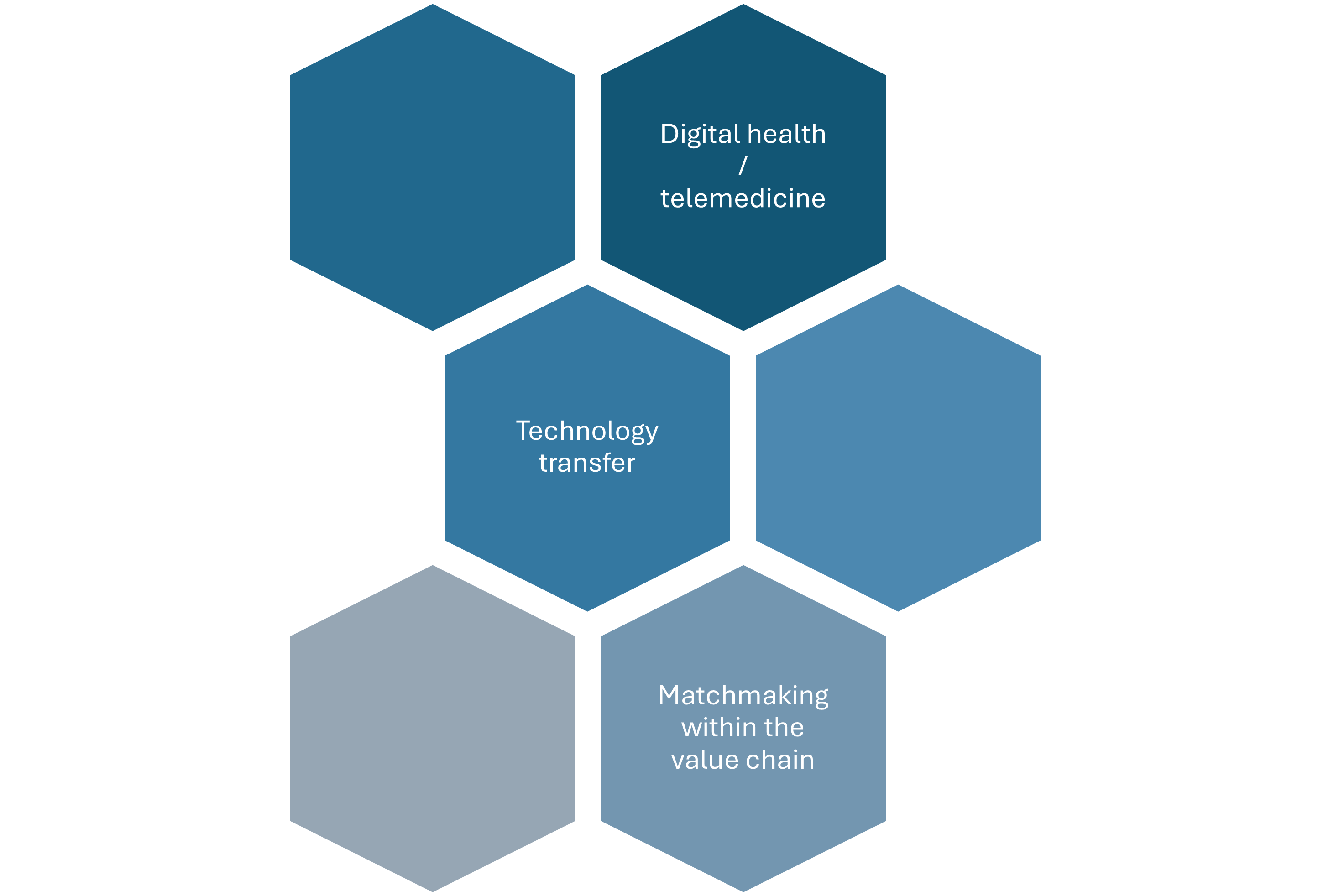Medical Technologies
Context
Europe faces rising and potentially unsustainable health and care costs, mainly due to the increasing prevalence of chronic diseases , to an ageing population requiring more diversified care and to increasing societal demand. Healthcare systems are challenged at an unprecedented level in terms of quality of service and cost. The digital transformation of society is also expected to have a deep impact on active and healthy ageing as well as monitoring patients with chronic diseases. The MedTech4europe project under this MedTech partnership developed a unique analysis of eight top notch MedTech ecosystems in Europe, defined several good practices and created a transfer of knowledge between partners.
Year established: 2016
Regions (lead and partner)
- Leading regions: Limburg (South Netherlands - NL), Copenhagen Capital Region Denmark (DK)
- Participating regions: Aragon (ES), Extremadura (ES), Basque Country (ES), Catalonia (ES), Auvergne Rhone Alpes (FR), Pays de la loire (FR), Ile-de-France (FR), East Netherlands (NL), North Brabant (NL), Emilia Romagna (IT), Flanders (BE), Moravia (CZ), Helsinki-Uusimaa (FI), Ireland (IE), Lombardy (IT), Northern Ostrobothnia (Pohjois-Pohjanmaa) (FI), Piedmont (IT), Slovenia (SI), South Denmark (Syddanmark) (DK), South Transdanubia (HU), North East Romania (RO), Thüringen (DE)

Mission
The mission of the Medical Technologies partnership is to support Medical technology as a way to offer new opportunities to address challenges by increasing the efficacy of healthcare and limiting the cost. It also wants to give participants more insights in best practices of European ecosystems and share ideas and chances for funding.
Objectives
The health transition focuses on a transition to a more efficient care system where people grow older in a healthier and happier way. Specific objectives are:
- Take up challenges like the Regional Innovation Valleys in Health to be established;
- Empower the participation of citizens and transforming the care cycle to more person-centred models;
- Ensure better access to healthcare for all;
- Create smart, scalable and sustainable solutions building on new innovation opportunities.
Main activities
The main activities of the MedTech partnership include peer learning on innovation and funding strategies, launching new collaborative projects, and connecting partners for potential cooperation. A mapping exercise has been completed (see initial priority results below), and a funding support service has been initiated under the S3CoP framework. Now, a shortlist of priority themes will be aligned with relevant funding opportunities.

Organisations involved
Belgium:
- Province of Limburg (BE)
- VITO NV (BE)
- Medvia (BE)
Czech Republic:
- Moravian-Silesian region (CZ)
Denmark:
- Capital Region of Denmark (DK)
- Danish Life Sciences Cluster (DK)
- South Denmark European Office (DK)
France:
- La region Auvergne Rhone Alpes (FR)
- La region Pays de la Loire (FR)
- South Denmark European Office (DK)
Germany:
- Ministry of Economy, Tourism, Agriculture and Forest (Sachsen Anhalt)(DE)
- Bio Analytik Muenster (DE)
- LEG Thueringen (DE)
Hungary:
- South Transdanubian Regional Innovation Agency Nonprofit Ltd (HU)
Ireland:
- Tyndall National Institute (IE)
- University College Cork (IE)
Italy:
- Area Ricerca e Innovazione (ART-ER)(IT)
- CNR-STIIMA (IT)
- Clust-ER Industrie della Salute e del Benessere (IT)
- Università di Bologna (IT)
- Bio Industry park (IT)
Romania:
- North East Region (RO)
Slovenia:
- EDUCELL d.o.o (SI)
- SIH EEIG (SI)
Spain:
- Aragon Health Cluster (ES)
- Accio Catalonia trade and investment (ES)
- Basque Health Cluster (ES)
- FundeSalud (ES)
The Netherlands:
- OOST NL (NL)
- Flanders Bio (NL)
- The Province of North- Brabant (NL)
Other:
- Healthday
Shared smart specialisation areas
Prediction:
- To better predict health risks.
Prevention:
- Considerable health gains can still be achieved with prevention.
Personalisation:
- Tailoring medical treatments to a patient’s individual profile.
Participation:
- People start to participate in and contribute towards their own care. The patient takes their care into their own hands and acts accordingly.
Related projects
- MedTech4europe: This Interreg europe Project focuses in optimizing the impact of public policies in favor of research and innovation facilities in the field of medical technologies. (https://projects2014-2020.interregeurope.eu/medtech4europe/)
- S3MARTMED: The new ESCP-S3 project S3martMed gathers 5 European Clusters dedicated to Healthcare and Medical technologies. These are Lyonbiopole (Auvergne-Rhône-Alpes), BioWin (Wallonia), BioRegioStern (Baden-Württemberg ), bioPmed (Piedmont), MedSilesia (Upper Silesia). The purpose of the starting initiative is to foster interregional and cross-sectoral cooperation between European clusters and their SME members in the field of medical technologies through the establishment of a unique cluster partnership. Through its action, the partnership will participate to the implementation of the Smart Specialisation policies with their Regions and encourage future investments in medical technologies. (https://clustercollaboration.eu/content/s3martmed)
- AI4DIAG: The project is funded by the European Union’s COSME programme and has a triple ambition: fostering companies’ development, fostering Regions’ co-investments and laying the foundation of a long term collaboration strategy between clusters in order to boost industrial modernisation of diagnostics companies in order to reinforce their international leadership. (https://ai4diag.b2match.io/page-1131)
Contact
- Ingrid Relou, Province of Limburg, ia.relou@prvlimburg.nl.
- Anja Storgaard, Capital Region of Denmark, anja.storgaard@regionh.dk.
- 3 Platform MedTech Province of Limburg and Capital Region of Denmark, s3pmedtech@prvlimburg.nl
Latest news and upcoming events
- On September 10 & 11 2024 the joint meeting “Collaborative Initiatives & South Netherlands Medtech Ecosystem Exploration” by both the S3 Platform MedTech and the Smart Health Pilot Vanguard Initiative took place. The meeting was an inspiring mix of interactive sessions, inspiring site visits, and insight on funding opportunities, matchmaking and collaboration opportunities!
- Participants also actively joined co-creation sessions focused on healthcare digitalization, AI for rehabilitation, and personalized healthcare, where they exchanged ideas and discussed practical collaboration.
- https://www.linkedin.com/posts/ingrid-relou-8633351_s3cop-journey-eufunding-activity-7239643652749230080-wUbV?utm_source=share&utm_medium=member_desktop
- https://www.linkedin.com/posts/vanguard-initiative-smart-health-pilot_s3cop-journey-eufunding-activity-7239568109160824832-fawN?utm_source=share&utm_medium=member_desktop
- November 13 2024: Funding support for projects on Rehabilitation & digitalisation, online
- December 5 2024: MedTech platform meeting: online

